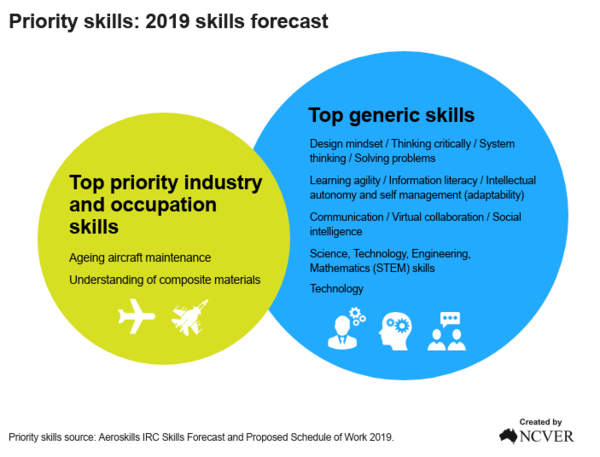
Industry insights on skills needs
The Aerospace IRC’s 2019 Skills Forecast was the last skills forecast published by the IRC. It identified specific areas requiring further skill development, namely skills in maintenance of ageing aircraft and understanding of composite materials as priority areas for skill development. In addition, the five generic workforce skills listed as being most important are:
- Design mindset/Thinking critically/Systems thinking/Solving problems
- Learning agility/Information literacy/Intellectual autonomy and self-management
- Communication/Collaboration including virtual collaboration/Social intelligence
- Science, Technology, Engineering and Mathematics (STEM) skills
- Technology.
In a survey conducted by IBSA Manufacturing (see the 2019 Skills Forecast), industry respondents from across all states and territories identified an ageing workforce and a shortage of skilled workers as key workforce challenges for the Aerospace sector. Addressing the ageing workforce was impacted by constraints to the supply of skilled employees.
According to the 2019 Skills Forecast, industry consultations indicated businesses were reluctant to take on new young people as graduates were unable to obtain licences without significant additional inputs. However, industry was confident that alignment between the Civil Aviation Safety Authority (CASA) requirements and VET requirements would significantly improve conditions for recruitment of younger people to the industry.
A project comprising two stages is progressing the alignment of VET qualifications with industry’s licensing requirements. The first stage was approved by the Australian Industry and Skills Committee (AISC) and received Ministerial endorsement, with training package components expected to be available by the end of 2022. The second stage requires the upgrade of 78 units and three qualifications and, as of November 2022, is flagged as a priority project to start in 2023.
Further, the 2019 Skills Forecast indicated the lack of harmonisation of Australia’s regulations with other leading aviation countries was another issue impacting the supply of skilled workers. The National Emerging Aviation Technologies Policy Statement indicated international harmonisation in training and competency requirements will be pursued. Separately, but related to the issue to the supply of skills, the Australian Government’s Women in the Aviation Industry Initiative may help the aviation industry meet future demands for skilled workers.
The 2019 Skills Forecast also reported the advance in technologies, including on-board digital automation and production methods would likely to continue to challenge the aviation industry. Further, technology-based solutions and more automated maintenance were expected to increase demand for analytical skills, digital literacy, information management and the development and implementation of mobile applications.
The former Training and Skills Commission (now the South Australian Skills Commission) report Aerospace Workforce Insights stated COVID-19 had increased demand for automation, including autonomous vehicles, in the aviation industry. Indeed, an area of growth was drone technology, and the Aviation Industry Reference Committee proposed to develop a new qualification to address skills and knowledge requirements for operators. Nationally, the Australian Government’s National Emerging Aviation Technologies Policy Statement outlined how the Government will support people, businesses and industry to adopt new and emerging digital aviation technology.
Additionally, digital transformation has resulted in technological advances in air traffic control operations and control towers are rapidly becoming more digitised, which will require upskilling of air traffic controllers.
Separately, the Aerospace Workforce Insights report finds data analytics, Artificial Intelligence (AI) and machine learning skills will be needed to support the growing space industry.
The Queensland Aerospace 10-Year Roadmap and Action Plan stated that industry raised concerns about potential shortages of skilled engineers in the aerospace manufacturing base within five to six years, however Australia has both a strong need and opportunity to help meet this expected shortfall in Australia and in the Asia-Pacific region.
Separately, the COVID-19 pandemic caused significant disruption to the aviation and many large aerospace manufacturers, according to the Aerospace Workforce Insights report, and recovery will take time.


